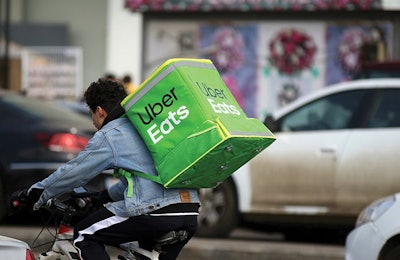
The American consumer keeps changing, but the desire for a cheap, fast and tasty meal remains.
As part of the 2019 Chicken Marketing Summit, a panel of current and former executives in the protein supply chain for national retailers said their consumers continue to ask for value, convenience and flavor at meal time. The panelists also weighed in on the future of the home delivery market. The event took place on July 23, 2019, in Charleston, South Carolina.

From left: Tim Scheiderer, Inspire Brands; Michael Billings, ButcherBox; John Atkinson, PFSbrands and Frank Thurlow, formerly with Southeastern Grocers. (Photo by Austin Alonzo)
The panelists were:
- John Atkinson, director of purchasing and forecasting at PFSbrands. PFS, based in Holt’s Summit, Missouri, is a national foodservice provider and the parent company of 1,500 quick service locations in grocery and convenience stores branded as Champ’s Chicken, Cooper’s Express and BluTaco.
- Michael Billings, head of meat procurement at ButcherBox. The company, based in Boston, ButcherBox delivers grass-fed beef, organic chicken, heritage breed pork and wild-caught salmon directly to consumers through a subscription model.
- Tim Scheiderer, director of protein supply at Inspire Brands Inc. Inc. Atlanta-based Inspire is a multi-brand restaurant company with a portfolio including more than 11,200 Arby’s, Buffalo Wild Wings, SONIC Drive-In, Rusty Taco, and Jimmy John’s restaurants around the world.
- Frank Thurlow, formerly with Southeastern Grocers Inc. (SEG). The Jacksonville, Florida company is one of the largest grocery store operators in the country. It is the parent company of BI-LO, Fresco y Más, Harveys Supermarket and Winn-Dixie grocery stores located in Alabama, Florida, Georgia, Louisiana, Mississippi, North Carolina and South Carolina.
What diners want
Although there is elevated concern about concepts like animal welfare and environmental sustainability, the deciding factors for diners and shoppers are still often convenience, value and flavor.
Restaurant operators are looking to please the majority of consumers who are focused on these three factors. Both Scheiderer and Atkinson said they are focusing on the fundamentals of what people like about their businesses.
Scheiderer used Buffalo Wild Wings as an example. The chicken wing-focused chain is refocusing its brand identity as America’s sports bar, and is elevating its menu as well as its food plating. In addition, it is bringing back discount promotions, like half-priced Tuesday, to bring the value-minded consumer in.
Atkinson said his customers value consistency across locations. In the convenience space, the consumer wants to know they are getting the same quality product everywhere they go. Also, there is little demand for free-range or organic products in this space.
What shoppers want
Grocers, on the other hand, must please a wide audience. They cater to both higher income consumers looking to explore a new trend and the lower income consumers looking to get as much value as possible.
Thurlow said grocers like SEG operate three tiers of programs. The first tier is the value, commodity product. The second tier contains the no-antibiotics-ever (NAE) products. The third tier contains the organic and other high-end specialty products. Not all stores have all three tiers, he said, as stocking depends on the location of the store and the income of the clientele.
Another factor to consider, he said, is the age of the shopper and the time of the year. Younger consumers are more interested in value claims and the NAE products. Shoppers will also spend more on higher tier and organic products around the holidays, too.
Most consumers are concerned with the label claims on their food, too. Retailers respond to consumer trends in this department as best they can, Thurlow said, but they depend on suppliers to deliver. Increasingly, he said, consumers are paying attention to the protein content of food. Some packages are even printing protein per serving on the front rather than the back to win sales.
The cost of convenience
In the Amazon age, people want everything delivered fast and free. Third-party and smartphone-based services like Uber Eats, Doordash and Postmates are expanding meal delivery to potentially every restaurant. In this environment, retailers need to adapt or risk falling behind.
Atkinson said for both shopper and seller, there are two factors to consider: the cost of convenience and the state of the art in technology.
For the buyer, the cost of convenience translates to the service charges, delivery fees and other add-ons that come with getting a hot meal delivered to the house. The question remains, however, of how much is too much for it to be worth the convenience.
For the seller, the constant advances in delivery technology and infrastructure should be considered. He said the current meal delivery logistics system is only going to become more advanced. As that happens, the cost of delivery for retailers, and the cost of convenience, will drop as well.
How retailers are delivering
Scheiderer said at Buffalo Wild Wings, third-party delivery is available but the costs to both the restaurateur and the consumer show that this won’t be a growth area for the brand. Instead, it wants to drive growth at the bar.
The size of the delivery market, he said, is hard to quantify but nevertheless it should not be ignored. For now, Inspire isn’t formally partnering with any third party services for delivery. Nevertheless, he said, the trend cannot be ignored
Thurlow said third-party meal couriers, meal kit companies and Amazon, which is now delivering food, created this environment and modern retailers need to live in it.
From a grocery standpoint, the highest area for potential growth in delivery and curbside pickup are the center store items. Grocers and online retailers, like Amazon, are just scratching the surface of this market however, Thurlow said.
Delivery of fresh items requiring refrigeration is more challenging. Grocers may even refrigerate more center store aisles to stock more meal kits and ready-to-cook items aimed toward the grab and go shopper. Amazon could even roll out its own, limited meal kit offerings, too.
ButcherBox, for its part, is not seeing any slowdown in its sales and predicts continued growth. Billings said after five years the subscription-based business model is seeing no signs delivery growth will slow soon.


















